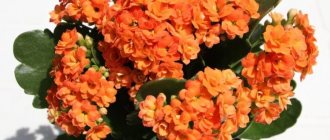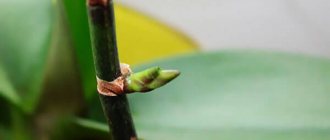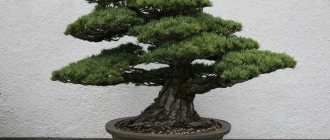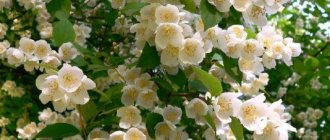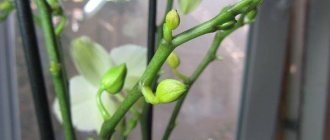On what shoots does hydrangea bloom?
If the hydrangea does not bloom, you first need to find the reason; the reasons may be different for different types. Large-leaved (garden) hydrangea (Hydrangea macrophylla), the most common species, blooms on last year's shoots; flower buds begin to appear in late summer, which will develop the following year. Hydrangea paniculata, on the contrary, blooms on the shoots of the current year; the flowers develop only in the spring. This difference is of great importance when caring for the shrub and is a hint as to why the hydrangea does not bloom.
Varieties of hydrangea
Why doesn't hydrangea bloom for a long time?
On a note! There are many varieties of hydrangea. Many varieties are not suitable for outdoor cultivation. But there are also those that decorate the garden area and do not require scrupulous care and maintenance.
Most often in gardens and personal plots you can find the following types of hydrangia:
- Grandiflora - has large inflorescences and is distinguished by an abundance of flowering. Inflorescences are, by their nature, sterile. Large-leaf variety, remontant;
- Lime light - has greenish flowers, which change to soft pink by the end of summer. Grows up to 2 meters in height;
- Pinky-Winky - distinguished by conical flowering. The average height is 1.7 meters. Inflorescences are bright pink;
- Phantom - also has cone-shaped inflorescences, but grows up to 2 meters in height. The color is cream, which changes to soft pink towards the end of flowering;
- Vanilla Fraze is a chic small-leaved garden shrub, characterized by dense flowering. The color of the flowers is rich pink;
- Daruma paniculata - has small flowers, which at the beginning of flowering are pink in color, which changes to purple towards the end. At the same time, the foliage of the bush also becomes red. A low-growing variety, reaching a height of about 1 m.
Daruma paniculata
Kidney freezing
Large-leaved hydrangea often does not bloom due to freezing. In the fall, flower buds appear on the shoots of the current year, which must survive the winter. However, flower buds are quite sensitive, and if frost occurs quickly (for example, in late September or early October), the buds may freeze and not develop in the spring.
If only the flower buds freeze, the bush will become covered with leaves and will look beautiful, but will not bloom. In this case, you need to fertilize and wait until next year. If the entire plant freezes, the bush will not develop at all in the spring and will have to be thrown away. To avoid freezing, you need to insulate the bushes. The roots are covered with leaves or bark; a hood made of agrofibre can be put on the shoots.
Although bigleaf hydrangea can be grown successfully outdoors, the most valuable varieties can be planted in large containers. For the winter, the containers are placed in a (necessarily) unheated room (annex, garage), watering every 2-3 weeks.
Why don't hydrangeas bloom?
Photo from the author's garden
Two questions are most often asked by buyers: why don’t large-leaved hydrangeas bloom, and if they do bloom, why not blue flowers? To get guaranteed flowering, you need to try - after the first frost, tear off the leaves and leave the top two. Remove old branches - this stimulates the formation of powerful basal shoots, cut out weak shoots, they are unproductive and often die in winter. Do not cut off the apical buds under any circumstances - the largest inflorescences develop from them, and some varieties bloom exclusively on the tops. Carefully bend the remaining shoots to the ground, the lower the better, do not isolate them from the ground in any way (this is a common mistake), the upper part of the bush should lie on the ground. Cover the tops with lutrasil (spunbond, agril) and cover the entire plant with peat or ordinary soil (I take it from the beds and take it back in the spring). There should be at least 10-15 cm of soil above the plant, and if you are not sure about the frost resistance of the variety, you can cover the top with lutrasil-60. In fact, the process is not complicated, and the result exceeds expectations.
Popular articles Rosa Mondial: cultivation and care in open groundIn the spring, you have to dig up hydrangea late, sometimes in early June, because... flower buds are afraid of return frosts. But, if you live in a country house, then you can take a risk - dig it up, and if there is a threat of freezing, wrap the bush with lutrasil in 2 layers
When removing the shelter, carefully fold back the lutrasil along with the soil so as not to damage the buds, which by this time are usually already moving forward. Raise the shoots and shade them with lutrasil for the first time, remove it on a rainy or cloudy day
Large-leaved hydrangeas bloom very early; their inflorescences become colored already in early July, when paniculata are just gathering their strength.
Why did the blue hydrangea suddenly turn pink? The fact is that hydrangeas need aluminum salts to form blue inflorescences, for example, “Rainbow” hydrangea coloring agent. It must be applied in liquid form, but if the weather is rainy, you can bury a teaspoon in several places around the bush, it will slowly dissolve and be absorbed by the plant. But aluminum only works on very acidic soil, so during the season it is necessary to acidify the soil several times - dissolve 50 g of citric acid in 10 liters of water and pour the soil under the plant in several approaches so that the solution reaches even the deep roots. To prevent water from spreading, make a cushion of soil around the plants. These activities should be carried out at the end of August-September, that is, at the time of flower bud formation for the next year, but if you did it at another time, it will not be worse, and then your hydrangea will again have blue inflorescences.
Errors in care
Another reason why hydrangea does not bloom is two mistakes in care, insufficient fertilizer and too little water. In both cases, the plant can produce buds and even develop some flowers, but the inflorescences will be anemic and small, withering and turning yellow in the summer. If the bushes are not watered regularly, daily, the plants are unlikely to survive until the next season.
Fertilizer is also important. Flowering shrubs need a lot of nutrients. Because the shrub has large leaves and produces many huge inflorescences, it requires a lot of nutrients. You should fertilize 3-4 times a year if you use granular fertilizer or every second watering if you use water-soluble fertilizers.
The use of fertilizers is closely related to the resistance of the shrub to frost!
Spring and summer. In spring, you can apply complex fertilizer Agricola Aqua. A plant strengthened with nutrients is more resistant to adverse environmental factors, grows faster and produces more flower buds.
Autumn. From mid-July you need to stop using nitrogen fertilizers. Nitrogen stimulates plants to create new shoots and green mass; hydrangeas should be ready for winter rest from August.
However, it is worth using special autumn fertilizers to expand the root system, so that the plants will be better prepared for winter.
How to make hydrangea bloom?
The most important role for this crop is played by the composition of the soil. If hydrangea does not bloom for a long time, then it is advisable to carry out chemical tests with subsequent adjustment of fertilizing. In serious cases, it is recommended to transplant the bushes to a new location. To increase the decorative value of a beautiful cultivated plant, a number of agrotechnical measures should be carried out during the season:
- pruning;
- feeding;
- watering;
- treatments for diseases;
- soil acidification.
Soil acidity for hydrangea
Much when growing plants depends on the quality of the soil. Beginner gardeners are often concerned about the question of why hydrangeas do not bloom, what to do when inflorescences do not form for several seasons with good care? It is imperative to check the acidity level. The optimal indicators for this flower are within pH 5.5 (slightly acidic and moderately acidic soils).
Methods for soil acidification:
- Electrolyte solution 1 ml/10 l of water per bush.
- Citric acid 1 teaspoon/12 l.
- Oxalic acid 1.5 teaspoons/10 l.
- Potassium nitrate 40 g/10 l.
Pruning hydrangea
It should be remembered that for the large-leaved variety, only sanitary cutting of dry growth and careful thinning are used. In the question of how to prune paniculata and tree hydrangea, you should use the following recommendations:
- Work is carried out before the buds open.
- Until the age of 3, only sanitary cutting is done.
- Old branches are removed, leaving 3-5 buds.
- The growth growing inside the bush is thinned out.
- Weak growth and branches without buds are removed.
- In autumn, fading inflorescences, intersecting branches and foliage in the lower part of the trunk are cut out.
Watering hydrangea
Soil moisture for this crop is required throughout the warm season. Drying out the top layer is often one of the reasons why hydrangea does not bloom at home. Let's consider the main recommendations on the quantity and frequency of watering, and the quality of water used:
- The volume of water used is up to 20 liters per plant.
- In the question of how to water hydrangea, the composition of the liquid is important. Lime impurities negatively affect the development and flowering of bushes. It is better to take water that has stood for up to 5 days or rainwater.
- Watering frequency – up to 2 times a week.
Feeding hydrangea
Potassium-phosphorus preparations significantly enhance flowering. Nitrogen compounds have a greater effect on the development of the crown, so such fertilizer for hydrangea is important before the start of sap flow or at the beginning of growth. Nutrients are added at the following times:
- After the snow melts
- urea in a dosage of 15 g/10 l or saltpeter 30 g/10 l. - Budding period
– superphosphate 20 g/10 l, potassium sulfate 20 g/10 l. An alternative option is complex formulations (nitroammophoska, Agricola, Fertika Kristalon). - After flowering
- diammofoska 20 g/10 l.
Preparing hydrangeas for winter
It is advisable to know exactly the type of flower you are dealing with. The large-leaved variety suffers the most from the cold; its flowering buds form on last year's branches and are more often damaged by frost. For the tree-like and paniculate varieties, sheltering the hydrangea for the winter in a temperate climate is not required; the buds bloom here at the current growth.
Preparing for wintering hydrangea is as follows:
- From mid-summer, stop nitrogen fertilizing, using mainly phosphorus-potassium compounds.
- In order for the shoots to quickly become lignified, the frequency of watering should be reduced by autumn, and it is advisable to tear off the lower foliage.
- Varieties of tree and paniculate varieties can be hilled in the fall, and shelter can be created only for young, immature seedlings.
- Large-leaved varieties are best covered for wintering with a layer of agrofibre stretched over a wooden frame. In harsh climates, cover the top of the structure with additional spruce branches or dry leaves.
Prevention of hydrangea diseases
During unfavorable seasons, this crop is affected by non-infectious and infectious diseases. In the first case, climatic factors (heat, prolonged cold, heavy precipitation) or unsuitable soil composition lead to the falling or blackening of leaves. Such hydrangea diseases are eliminated by changing the acidity of the soil on alkaline soils and regular fertilizing (Agricol, Ferovit). In addition, there are fungal infections and dangerous viruses that can cause a lot of trouble.
Let's look at the most dangerous ailments of hydrangea and the drugs used for prevention on this crop:
- Gray rot
- tissues soften, become watery, and become covered with plaque. Treatment with Fundazol helps. - Powdery mildew
- the formation of green or yellowish spots, a bluish coating appears on the bottom of the plates, and the shoots are deformed. The products “Skor”, “Topaz”, “Fitosporin” help. - Septoria
- the formation of brown spots and the death of shoots. Copper-containing preparations are used for preventive purposes and for treatment. - Ring spot
is a viral disease of a necrotic nature, the foliage wrinkles and becomes covered with spots. It is necessary to use healthy seedlings, equipment treated with antiseptics, and spray the plantings against insects in a timely manner. Affected shoots and foliage must be cut out and burned.
Hydrangea transplant
This operation is performed when moving a plant to a new place or to divide overgrown plantings. It is advisable to replant a hydrangea bush in the spring at positive temperatures after the snow has melted or from the end of August to October. The timing of work is determined depending on the weather in a particular region. Let's consider the basic recommendations when preparing planting holes:
- The hole size is up to 0.6x0.6 m.
- The distance between neighboring hydrangea flowers is from 1-1.5 m.
- First prune the above-ground part of the hydrangea to align it with the damaged root system.
- Remove the bush with a clod of earth after preliminary watering, moving the shovel 25 cm from the center of the bush.
- Do not deepen the root collar, trying to place it at the old level.
- Cover the roots with soil and water the bushes, compacting the soil as it settles.
- It is recommended to mulch the soil with bark or peat.
Trimming
Pruning is necessary to help hydrangeas develop and produce beautiful flowers. But pruning is also a direct reason for the lack of flowering. The reason is simple: paniculata hydrangea blooms on the shoots of the current year. If you prune the shoots too much during spring pruning, flowers will not appear; you will have to wait until the next season.
Proper pruning of hydrangea is to shorten the shoots to the fourth bud in the fall. The remaining buds will produce new branches. You can also do formative pruning and give the bush the desired shape, but flowering may be weakened. If the bush has grown too much, pruning is needed.
Since hydrangea inflorescences are often used for dry bouquets, be careful with pruning. In order for the plant to bloom next year, only the inflorescence itself with a short 3-4 cm stem is cut off.
Improper watering
Hydrangea got its Latin name Hydrangea (“vessel of water”) for its love of moisture. This is especially noticeable in young (less than three years old) plants. The soil around the roots of the hydrangea should not dry out, so in the summer heat it is watered every 3 days, and in cool weather - once a week. Depending on the size of the bush, each plant requires from 1 to 1.5 buckets of water. It is equally important to consider the quality of the soil. Heavy and clayey soils are watered less frequently, while sandy and sandy loam soils, respectively, are watered more often and more abundantly.
To water hydrangeas, it is better to use rainwater or tap water that has been standing for at least 4-5 days.
Remontant varieties
‹ Left Right ›
Remontant varieties of large-leaved hydrangea have a distinctive feature - the shrub blooms twice a year. The first bloom is in the spring (on last year's shoots) and the second begins in late summer or autumn (on the current year's shoots).
Varieties of large-leaved hydrangea blooming on the shoots of the current year:
All Summer Beauty, Dooley, Endless Summer, Generale Vicomtesse de Vibraye, Lilacina, Mariesii Variegata, Madame Emile Mouillere, Nikko Blue, Penny Mac, Bloom Struck, David Ramsey, Decatur Blue, Oak Hill, Twist-n-Shout and Veitchii.
If you find it difficult to achieve flowering, we recommend varieties that bloom on the current year's shoots, the reliable panicle hydrangea (Hydrangea paniculata), varieties:
- Phantom - with huge white-cream inflorescences.
- Limelight - with initially white, then light green, pinkish inflorescences at the end of flowering.
- Grandiflora is a variety with large white flowers.
- Pink Diamond is a good variety with pink flowers.
- Kyushu is a variety with conical white inflorescences.
Diseases and pests
A very common reason why hydrangea blooms poorly is disease. Sometimes even established buds begin to fall off if the plant becomes sick. The most common cause is fungi: powdery mildew, leaf spot or gray mold. A plant infected with fungal pathogens does not develop, growth and flowering slow down. You need to react immediately by spraying the plant with fungicides.
Often the cause of weakened flowering is pests, especially aphids. The feeding of aphids on the leaves is immediately visible; if flowers appear, they are small and often distorted. Tiny aphids can cause a lot of damage. It is better to pre-spray the bush for prevention.
